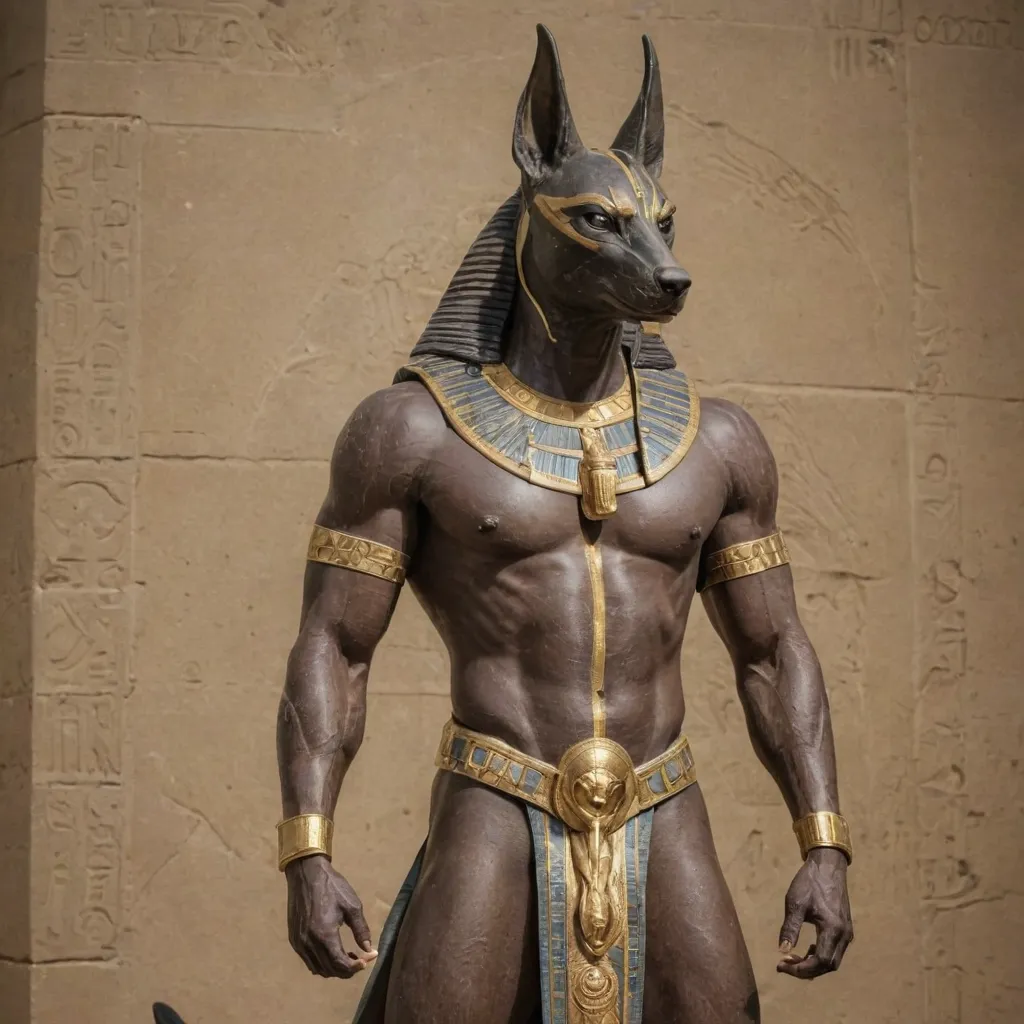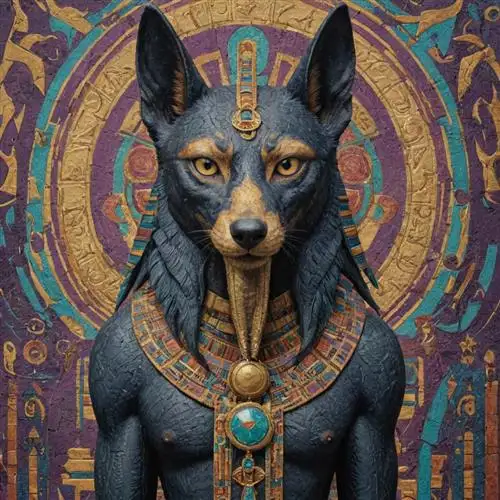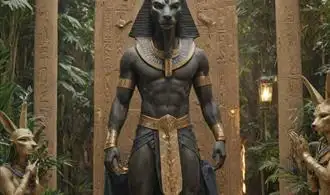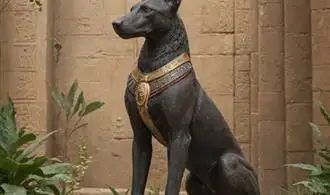
The Enigmatic Origins of Anubis
Anubis, the enigmatic jackal-headed god of ancient Egypt, has long captivated the imagination of scholars and enthusiasts alike. Delving into the mysterious origins of this revered deity, we uncover a complex tapestry of beliefs, symbolism, and cultural significance that have endured for millennia.
The origins of Anubis are shrouded in the mists of time, with scholars debating the exact nature of his emergence within the Egyptian pantheon. One widely accepted theory suggests that Anubis may have originated as a local deity in the region of Cynopolis, a city in Upper Egypt. In this region, the jackal was revered as a sacred animal, and it is believed that the image of the jackal-headed god developed from this local tradition.
Another intriguing hypothesis posits that Anubis may have been influenced by earlier deities, such as the funerary god Wepwawet, who was also depicted with canine features. The similarities between these two deities have led some scholars to suggest that Anubis may have evolved from or been closely associated with Wepwawet, reflecting the complex and interconnected nature of the Egyptian pantheon.
Regardless of his precise origins, Anubis quickly rose to prominence within the Egyptian religious landscape, becoming a central figure in the elaborate rituals and beliefs surrounding death and the afterlife. As the god responsible for the mummification process and the guardian of the necropolis, Anubis played a vital role in the journey of the deceased through the underworld.
Interestingly, Anubis's iconography and symbolic significance have been the subject of much scholarly debate. The jackal-headed figure is often interpreted as representing the transition between the living and the dead, with the jackal's ability to traverse both the world of the living and the realm of the dead making it a potent symbol of this liminal space.
Furthermore, the color black, which is associated with Anubis, has been linked to the fertile soil of the Nile River, as well as the mummification process itself. This connection between Anubis and the cycle of life, death, and rebirth has cemented his status as a pivotal figure in the Egyptian funerary tradition.
Anubis the Guardian of the Dead
Anubis, the enigmatic jackal-headed deity, holds a pivotal role in the pantheon of ancient Egyptian mythology. As the guardian of the dead, Anubis was responsible for the crucial process of embalming and guiding the deceased through the treacherous journey to the afterlife. His presence was paramount in ensuring the safe passage of the departed, making him a revered and indispensable figure in the intricate tapestry of Egyptian belief systems.
The importance of Anubis in the afterlife cannot be overstated. He was tasked with the meticulous mummification of the deceased, a process that was believed to prepare the body for the eternal existence in the realm of the dead. Anubis would carefully remove the internal organs, preserve the body, and wrap it in linen, ensuring that the physical form remained intact for the soul's return. This sacred ritual was not merely a practical endeavor but a deeply spiritual one, as Anubis acted as the intermediary between the mortal and divine realms.
Moreover, Anubis was responsible for weighing the heart of the deceased against the feather of truth, a pivotal moment in the judgment of the soul. This process, known as the "Weighing of the Heart," determined the fate of the individual in the afterlife. If the heart was found to be pure and free of sin, the soul would be granted passage to the eternal realm of the gods. However, if the heart was deemed heavy with sin, it would be devoured by the devouring monster, Ammut, condemning the soul to eternal damnation.
The role of Anubis as the guardian of the dead extended beyond the physical realm. He was believed to guide the deceased through the intricate and perilous pathways of the underworld, ensuring their safe passage to the afterlife. His presence was seen as a source of comfort and protection, as the journey to the afterlife was fraught with challenges and obstacles that only the unwavering guidance of Anubis could navigate.
In addition to his duties as the guardian of the dead, Anubis was also associated with the embalming process and the preparation of the deceased for burial. His black jackal-like appearance was symbolic of the mummification process, as the color black was believed to represent the fertile soil of the Nile River, which was essential for the regeneration and rebirth of the deceased in the afterlife.
Symbols and Iconography of Anubis
Anubis, the jackal-headed god, is one of the most iconic and recognizable deities in ancient Egyptian mythology. His symbols and iconography hold profound significance, offering insights into the multifaceted nature of this revered figure. From his distinctive canine-like appearance to the array of objects and motifs associated with him, the visual representations of Anubis convey the depth and complexity of his divine role.
At the core of Anubis' iconography is his distinctive jackal-headed form. The jackal, a cunning and adaptable canine, was chosen to represent Anubis due to its association with the desert and the underworld. This form not only visually distinguished Anubis but also symbolized his domain over the realms of the dead and the processes of mummification and burial.
Anubis is often depicted holding specific objects that further elucidate his responsibilities and powers. One of the most prominent symbols is the was scepter, a staff with a distinctive forked end, which represents his authority and control over the afterlife. Additionally, Anubis is frequently shown holding the ankh, the ancient Egyptian symbol of life, signifying his role in facilitating the transition from this world to the next.
The color black, associated with the fertile soil of the Nile River's banks, is also a significant symbol in Anubis' iconography. This hue not only represents the color of the mummified body but also symbolizes the regenerative and restorative powers of the underworld, over which Anubis presided.
Another important iconographic element is the scales of justice, which Anubis is often depicted weighing. This motif represents his role as the guardian of the underworld, responsible for ensuring the fair judgment of the souls of the deceased. The scales, with a feather on one side and the heart of the deceased on the other, symbolize the delicate balance between good and evil, life and death.
Anubis' iconography extends beyond his physical representation to the objects and environments associated with him. Funerary items, such as canopic jars used to store the internal organs of the deceased, often feature Anubis' likeness, highlighting his central role in the mummification process and the afterlife. Additionally, Anubis is frequently depicted in scenes of the underworld, surrounded by the symbols and motifs that represent the realm of the dead.
Anubis in Ancient Egyptian Rituals and Beliefs
Anubis, the enigmatic jackal-headed deity, held a revered and multifaceted role in the pantheon of ancient Egyptian beliefs and rituals. As the god of the dead, embalming, and the afterlife, Anubis was a central figure in the intricate web of funerary practices that defined the Egyptian approach to the hereafter.
At the heart of Anubis's prominence was his role as the guardian of the deceased, responsible for the crucial process of mummification. The jackal-headed god was believed to oversee the embalming of the dead, ensuring the preservation of the physical form that would serve as a vessel for the soul's journey into the afterlife. This sacred duty was not merely a practical matter but a profound spiritual responsibility, as Anubis's guidance was essential for the deceased to successfully navigate the trials and tribulations of the afterlife.
But Anubis's influence extended far beyond the realm of the dead. He was also revered as a psychopomp, a guide who would lead the souls of the deceased to the underworld and into the presence of Osiris, the lord of the dead. In this capacity, Anubis was responsible for weighing the heart of the deceased against the feather of truth, a symbolic representation of the individual's moral and ethical standing. This judgement, known as the "Weighing of the Heart," determined the fate of the soul, with those found worthy granted entrance into the eternal realm of the afterlife.
The Anubis Speaks - Bold Statements From the Jackal God article delves deeper into the powerful and enigmatic nature of this revered deity, exploring his bold proclamations and the profound impact they had on the ancient Egyptian worldview.
Anubis's presence was ubiquitous in ancient Egyptian rituals and beliefs, as the jackal-headed god was invoked in a myriad of ceremonial and funerary contexts. From the elaborate and meticulous mummification process to the intricate funerary rites that accompanied the deceased on their journey to the afterlife, Anubis's guidance and protection were considered essential. The very nature of the jackal-headed deity, with its associations with the wilderness, death, and the transition between the realms of the living and the dead, imbued Anubis with a sense of mystery and power that captivated the ancient Egyptians.
The Legacy of Anubis in Modern Culture
Anubis, the ancient Egyptian god with the head of a jackal, has left an indelible mark on modern culture, transcending the boundaries of his mythological origins. From art and literature to popular media, the image and symbolism of Anubis have been adapted, reinterpreted, and woven into the fabric of contemporary consciousness.
One of the most prominent ways Anubis has influenced modern culture is through his enduring presence in visual arts. The distinctive silhouette of the jackal-headed deity has become a recognizable icon, inspiring artists across various mediums. In fine art, Anubis has been the subject of countless paintings, sculptures, and installations, often used to explore themes of death, the afterlife, and the complexities of the human experience. Additionally, the god's likeness has been incorporated into graphic design, tattoo art, and even fashion, where his image conveys a sense of mysticism and ancient power.
Beyond the visual realm, Anubis has also made significant inroads into the world of literature and popular media. The god's role as the overseer of the dead and the mummification process has made him a recurring character in works of fiction, from ancient Egyptian-themed novels to contemporary fantasy and horror stories. In film and television, Anubis has been depicted in various capacities, from menacing antagonists to enigmatic guides, often serving as a conduit for exploring the themes of mortality, the afterlife, and the interplay between the mortal and divine realms.
The influence of Anubis extends beyond the traditional artistic and literary spheres, permeating into the realm of modern spirituality and alternative belief systems. The god's association with the underworld and his role as the protector of the dead have led to his incorporation into various pagan and occult practices, where his image and symbolism are utilized for rituals, meditations, and spiritual exploration. This resurgence of interest in Anubis and other ancient Egyptian deities has contributed to a broader cultural fascination with the mysteries and wisdom of the ancient world.
Furthermore, the legacy of Anubis can be seen in the way his name and iconography have been adopted by contemporary organizations, businesses, and even popular culture phenomena. From specialized funeral homes and cemeteries to video game franchises and metal bands, the invocation of Anubis serves to evoke a sense of tradition, mysticism, and the profound mysteries of life and death.
















